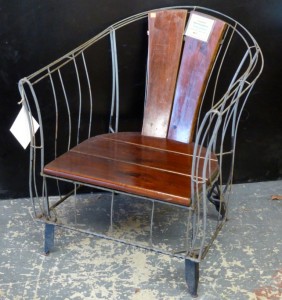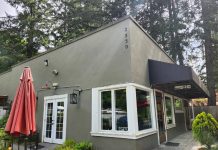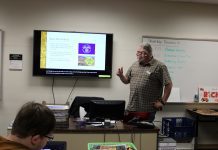
In our busy lives, it’s pretty easy to overlook where our furniture comes from, how it’s made, and the history of the materials from which it was built. But REvision Division, a modest part of RE Sources for Sustainable Communities’ RE Store, is trying to change that. By modeling reuse of everyday discarded materials and transforming them into gallery-quality furniture, this local non-profit is inspiring the public to make a shift and see discards as a valuable resource.
 Since 1993, the RE Store has been supporting RE Sources’ mission to promote sustainable communities through education, advocacy, recycling and the conservation of natural resources. When Kurt Gisclair moved to Bellingham from Alaska seven-and-a-half years ago to become the RE Store director, one of the many goals he had was to find additional pathways to enhance the value of the materials the store was already accepting.
Since 1993, the RE Store has been supporting RE Sources’ mission to promote sustainable communities through education, advocacy, recycling and the conservation of natural resources. When Kurt Gisclair moved to Bellingham from Alaska seven-and-a-half years ago to become the RE Store director, one of the many goals he had was to find additional pathways to enhance the value of the materials the store was already accepting.
“We first approached it with a value-added perspective, taking materials that we have and looking at things we can do to add value to certain materials to better serve the work we’re doing,” Gisclair explains. “We wanted to address more diversion of materials through repurposing and reuse, combining these materials into something and give it new life.”

It wasn’t until 2011 that they discovered the creative mind of Eberhard Eichner of Lummi Island and his talent for buying pieces from the RE Store and up-cycling them in his home shop. Much of his work focused on painting existing pieces. Soon he began dressing window displays in exchange for RE Store trade credit. His work was such a hit, and his passion for reuse so strong, that he was invited to work at the RE Store’s shop building furniture from reclaimed materials.
“Eberhard’s influence helped us shift from a value-added mindset to actively pursuing difficult-to-divert materials from the waste stream — shifting the focus to education outreach and behavior change,” Gisclair notes. “We wanted people to see the value and what the possibilities are to repurpose materials that are widely perceived as trash — wooden or flooring shorts, frame pieces, things that we wouldn’t normally accept at the RE Store.”
After winning a couple of small grants, Eberhard joined the RE Store as an employee and REvision Division was born. “Eberhard was incredibly innovative in finding ways to repurpose things everyone wants to get rid of like hollow core and bi-fold louver doors. He made them into blanket chests, keepsake boxes, arbors and trellises. In the first three years, he built over 500 pieces of furniture here,” Gisclair adds.

Soon, businesses began requesting custom work. The results are now spread throughout Whatcom County. For example, stand-up desks were built for Sustainable Connections, a whimsical bench now sits in the children’s department of Village Books, additional seating was added outside Uisce Irish Pub, and picnic tables adorn many Bellingham Parks and Recreation locations, to name just a few.
“All of this effort has been to educate people on how we can cut down on the use of virgin resources like the beautiful trees on the surrounding hillsides by keeping these materials from our garages and shops in the cycle and out of the landfill,” explains Gisclair.
Eberhard has moved on but his influence on the program remains. He worked with the existing lead designer and builder, Matt Vaughn, who studied Industrial Design and Painting at the University of Washington and worked for Second Use in Seattle. Vaughn’s 20 years of experience is broad — in carpentry, welding and electronics — and many of his current pieces are larger works that incorporate interesting finish details or metal elements with an industrial, mid-century modern look.
A second designer, David Spangler, has worked with the RE Store on and off for more than 15 years. In addition to being an expert in miniatures, “David has a keen eye for period-correct, turn-of-the-century craftsman and bungalow-style furniture and up-cycling,” Gisclair mentions.
All of the gallery-quality pieces are made from materials brought to the RE Store as waste, with the exception of a few small pieces of recycled scrap that is purchased. What gets built is a function of what customers want.

“People come to the RE Store constantly asking if we’ve seen a particular item, and that sparks our approach.” But REvision Division’s process is different than most people are used to. Normally, the first decision made is what type of furniture should be built, and then materials are chosen. “But our approach is, we have this odd selection of materials and we ask, ‘What can we create that uses the maximum amount that could also be repurposed or remanufactured a hundred or two hundred years from now?’ We want to keep this material in the cycle while building beautiful furniture our customers want that will also last that long.”
Another great feature of furniture made from repurposed materials is that it’s affordable. In general, RE Store offers items such as excess building materials at about half of their value when new. REvision Division furniture generally sells for the cost of production time and materials that went into making the piece. Small grants help subsidize the concept phase of development to keep the furniture easy on the wallet.
REvision Division’s creativity isn’t limited to the showroom. A new area of development they’ll continue to expand is partnering with local businesses to divert manufacturing byproduct. Itek Energy, a local solar panel manufacturer, donates high-tempered overlay solar panel glass that does not meet inspection specifications required for warranty. The nature of the glass is specialized and so it cannot be efficiently cut or recycled and the cost to dispose of it is quite high. REvision Division intends to keep tons of that waste in use by developing a greenhouse design, construction manual, and prototype kit that are now available to the public.

“That’s just one example of how we’re partnering to tackle the byproduct that can be repurposed and put to use,” Gisclair says. “It challenges us to design a usable product based on a steady flow of material that would otherwise be discarded.”
In only five years and with just one-and-three-quarters staff, REvision Division has developed more than 800 pieces of home furnishings. With results like that, they can only be limited by what their designers and customers can dream up next.









































